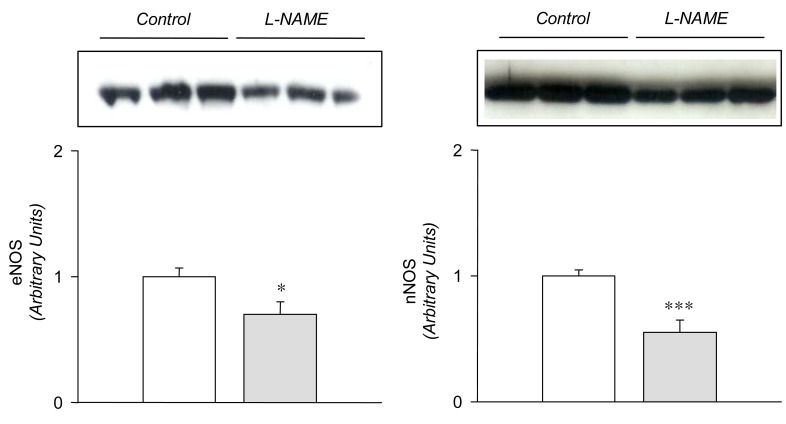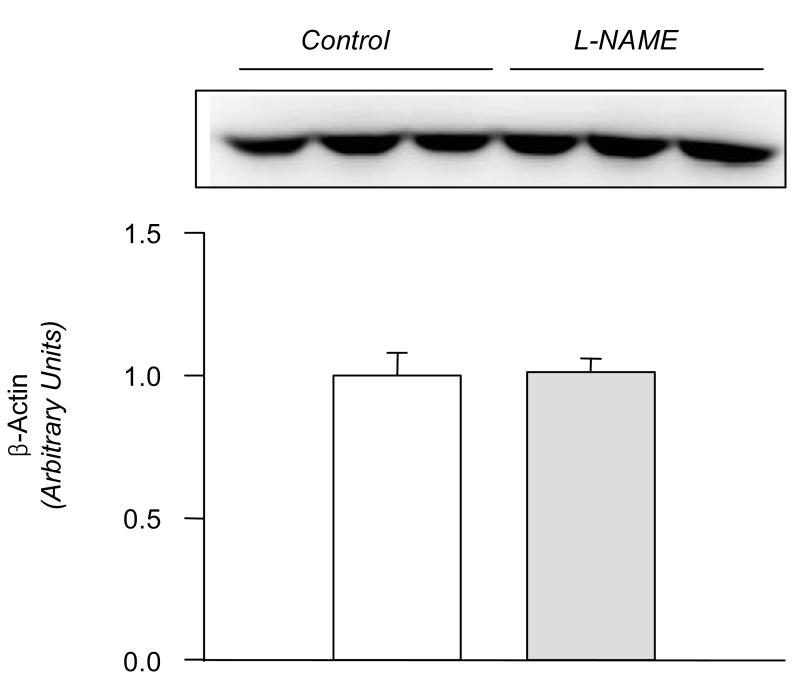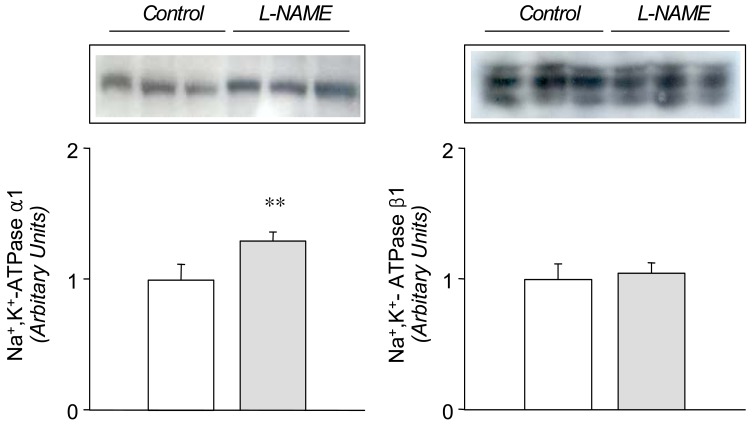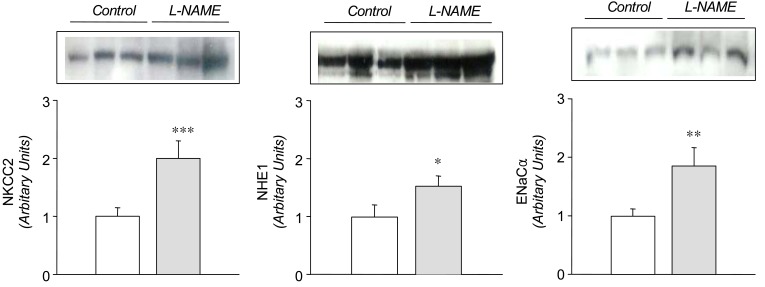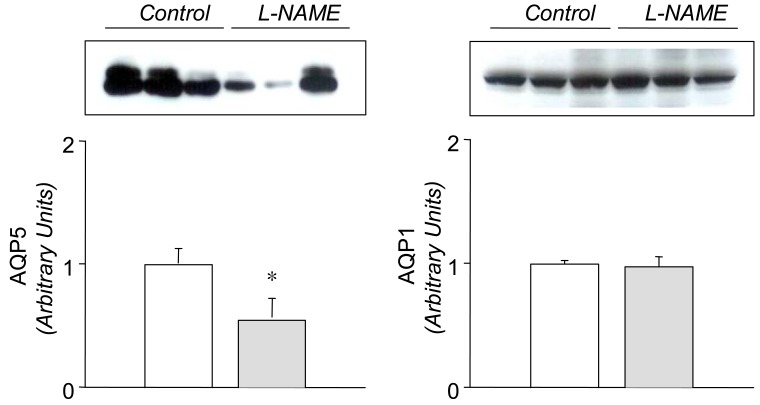Electrolyte Blood Press.
2008 Jun;6(1):9-14. 10.5049/EBP.2008.6.1.9.
Altered Expression of Sodium Transporters and Water Channels in the Submandibular Gland of Rats Treated with Nitric Oxide Synthesis Inhibitors
- Affiliations
-
- 1Department of Oral and Maxillofacial Surgery, Chonnam National University Professional Graduate School of Dentistry, Gwangju, Korea. ryusuny@jnu.ac.kr
- 2Department of Nursing, Chonnam National University College of Nursing, Gwangju, Korea.
- 3Department of Physiology, Chonnam National University Medical School, Gwangju, Korea.
- KMID: 2052300
- DOI: http://doi.org/10.5049/EBP.2008.6.1.9
Abstract
- A role of nitric oxide (NO) in the regulation of sodium transporters and water channels in the salivary gland was investigated. Male Sprague-Dawley rats were treated with NG-nitro-L-arginine methyl ester (L- NAME, 100 mg/L drinking water) for 1 week. The control group was supplied with normal tap water. The expression of Na+,K+-ATPase, type 2 Na+/K+/2Cl- cotransporter (NKCC2), type 1 Na+/H+ exchanger (NHE1), alpha-subunit of epithelial sodium transporter (ENaC), and aquaporin-5 (AQP5) and aquaporin-1 (AQP1) proteins were determined in the submandibular gland by Western blot analysis. Following the treatment with L-NAME, the expression of Na+,K+-ATPase alpha1-subunit, NKCC2, NHE1, and ENaC alpha- subunit increased significantly. On the contrary, the expression of AQP5 was significantly decreased, while that of AQP1 was not significantly altered. These findings indicate that the sodium transporters and water channels may be under a tonic regulatory influence of NO in the salivary gland.
MeSH Terms
Figure
Reference
-
1. Robertson MA, Woodside M, Foskett JK, Orlowski J, Grinstein S. Muscarinic agonists induce phosphorylation-independent activation of the NHE-1 isoform of the Na+/H+ antiporter in salivary acinar cells. J Biol Chem. 1997; 272:287–294. PMID: 8995260.
Article2. Peagler FD, Redman RS. Enzyme histochemical localization of Na(+),K(+)-ATPase and NADH-DE in the developing rat parotid gland. Anat Rec. 1999; 256:72–77. PMID: 10456987.
Article3. Robertson MA, Foskett JK. Na+ transport pathways in secretory acinar cells: membrane cross talk mediated by [Cl-]i. Am J Physiol. 1994; 267:C146–C156. PMID: 8048476.
Article4. Pirani D, Evans LA, Cook DI, Young JA. Intracellular pH in the rat mandibular salivary gland: the role of Na-H and Cl-HCO3 antiports in secretion. Pflugers Arch. 1987; 408:178–184. PMID: 2436139.
Article5. Case RM, Hunter M, Novak I, Young JA. The anionic basis of fluid secretion by the rabbit mandibular salivary gland. J Physiol. 1984; 349:619–630. PMID: 6737303.
Article6. Young JA, Cook DI, Evans LA, Pirani D. Effects of ion transport inhibition on rat mandibular gland secretion. J Dent Res. 1987; 66:531–536. PMID: 2442220.
Article7. Awayda MS, Tousson A, Benos DJ. Regulation of a cloned epithelial Na+ channel by its beta- and gamma-subunits. Am J Physiol. 1997; 273:C1889–C1899. PMID: 9435494.8. McNicholas CM, Canessa CM. Diversity of channels generated by different combinations of epithelial sodium channel subunits. J Gen Physiol. 1997; 109:681–692. PMID: 9222895.
Article9. Nielsen S, King LS, Christensen BM, Agre P. Aquaporins in complex tissues. II. Subcellular distribution in respiratory and glandular tissues of rat. Am J Physiol. 1997; 273:C1549–C1561. PMID: 9374640.10. Koyama Y, Yamamoto T, Tani T, Nihei K, Kondo D, Funaki H, et al. Expression and localization of aquaporins in rat gastrointestinal tract. Am J Physiol. 1999; 276:C621–C627. PMID: 10069989.11. Delporte C, Steinfeld S. Distribution and roles of aquaporins in salivary glands. Biochim Biophys Acta. 2006; 1758:1061–1070. PMID: 16537077.
Article12. Tobin G, Edwards AV, Bloom SR, Ekstrom J. Nitric oxide in the control of submandibular gland function in the anaesthetized ferret. Exp Physiol. 1997; 82:825–836. PMID: 9331552.
Article13. Lomniczi A, Suburo AM, Elverdin JC, Mastronardi CA, Diaz S, Rettori V, et al. Role of nitric oxide in salivary secretion. Neuroimmunomodulation. 1998; 5:226–233. PMID: 9730690.
Article14. Looms DK, Dissing S, Tritsaris K, Pedersen AM, Nauntofte B. Adrenoceptor-activated nitric oxide synthesis in salivary acinar cells. Adv Dent Res. 2000; 14:62–68. PMID: 11842926.
Article15. Takai N, Uchihashi K, Higuchi K, Yoshida Y, Yamaguchi M. Localization of neuronal-constitutive nitric oxide synthase and secretory regulation by nitric oxide in the rat submandibular and sublingual glands. Arch Oral Biol. 1999; 44:745–750. PMID: 10471158.
Article16. Toba H, Nakagawa Y, Miki S, Shimizu T, Yoshimura A, Inoue R, et al. Calcium channel blockades exhibit anti-inflammatory and antioxidative effects by augmentation of endothelial nitric oxide synthase and the inhibition of angiotensin converting enzyme in the N(G)-nitro-L-arginine methyl ester-induced hypertensive rat aorta: vasoprotective effects beyond the blood pressure-lowering effects of amlodipine and manidipine. Hypertens Res. 2005; 28:689–700. PMID: 16392774.
Article17. De Gennaro Colonna V, Rigamonti A, Fioretti S, Bonomo S, Manfredi B, Ferrario P, et al. Angiotensin-converting enzyme inhibition and angiotensin AT1-receptor antagonism equally improve endothelial vasodilator function in L-NAME-induced hypertensive rats. Eur J Pharmacol. 2005; 516:253–259. PMID: 15963975.
Article18. Ma T, Song Y, Gillespie A, Carlson EJ, Epstein CJ, Verkman AS. Defective secretion of saliva in transgenic mice lacking aquaporin-5 water channels. J Biol Chem. 1999; 274:20071–20074. PMID: 10400615.
Article19. Steinfeld S, Cogan E, King LS, Agre P, Kiss R, Delporte C. Abnormal distribution of aquaporin-5 water channel protein in salivary glands from Sjogren's syndrome patients. Lab Invest. 2001; 81:143–148. PMID: 11232635.20. King LS, Nielsen S, Agre P. Aquaporins in complex tissues. I. Developmental patterns in respiratory and glandular tissues of rat. Am J Physiol. 1997; 273:C1541–C1548. PMID: 9374639.21. Akamatsu T, Parvin MN, Murdiastuti K, Kosugi-Tanaka C, Yao C, Miki O, et al. Expression and localization of aquaporins, members of the water channel family, during development of the rat submandibular gland. Pflugers Arch. 2003; 446:641–651. PMID: 12838423.
Article22. Verkman AS, Yang B, Song Y, Manley GT, Ma T. Role of water channels in fluid transport studied by phenotype analysis of aquaporin knockout mice. Exp Physiol. 2000; 85 Spec No:S233–S241.
Article
- Full Text Links
- Actions
-
Cited
- CITED
-
- Close
- Share
- Similar articles
-
- Sympathetic and parasympathetic regulation of sodium transporters and water channels in rat submandibular gland
- Altered expression of sodium transporters and water channels following sympathetic and parasympathetic denervation in rat submandibular gland
- Autonomic Neural Regulation of Sodium Transporters and Water Channels in Rat Submandibular Gland
- Role of Nitric Oxide in the Regulation of Aquaporin-2 Water Channels in Rat Kidney
- Increased Expression of Sodium Transporters in Rats Chronically Inhibited of Nitric Oxide Synthesis

